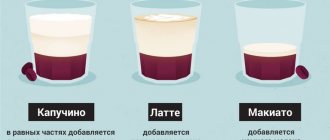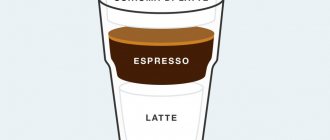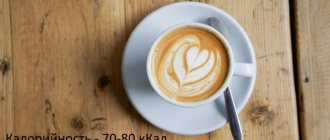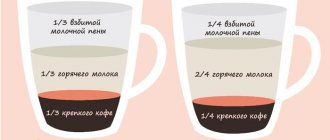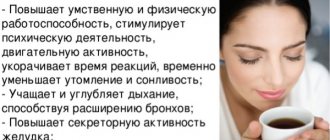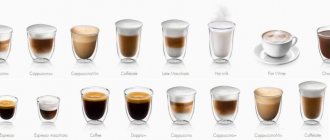Short story
Rough coffee is prepared according to a special method. The base is espresso with the addition of heavy cream and vanilla sugar. The ingredients are mixed in a milk jug (pitcher) and whipped in a coffee machine. If everything is done correctly, the result is an airy mass with a rich taste.
It is important to achieve a uniform texture and delicate creamy taste. To create true rough, you must strictly follow the recipe.
It is called a coffee cocktail, with a luxurious presentation and a unique creamy vanilla foam.
This is the only coffee drink whose homeland is Russia. Its story began in 1996 in the Moscow Coffee Bean store. An experienced barista with an original imagination came up with an unusual recipe to satisfy the whim of a demanding customer. Now raf has many fans and is rightfully considered one of the most delicious.
Read more about this in the article “Raf coffee: what it is and how to prepare it.”
Composition and calorie content
The cocktail includes a serving of espresso per 100 grams of cream, as well as sugar. Moreover, not only regular, but also vanilla is added. The calorie content of a 150 ml drink is 150 kcal. The high energy value is due to the addition of cream and sugar. If additional additives are added to the composition, there will be even more calories.
Raf coffee is a complete dessert that cannot be classified as dietary
It is not served along with halva and other sweets. The drink itself is quite sweet and nutritious.
Latte: stories from life
Latte is an Italian coffee drink based on espresso and medium-fat milk. It is important to serve it correctly - in a glass goblet, which stands on a saucer with a napkin. The highlight is the decoration with patterns of heated foamed milk. A favorite pattern among coffee lovers is a heart in the center of the glass. It is considered one of the most difficult and time-consuming to prepare.
It is recognized as the favorite hot drink of Italians. However, Russian gourmets are not inferior to coffee lovers from Italy. Read about it in the article “What is coffee latte.”
Features of making raf coffee
Espresso is used as the basis for preparing this coffee drink. If you want to prepare it at home, then, of course, you can use any type of coffee as a basis - both ground and instant.
The main thing is that during the preparation process no particles of beans from the grounds get into the coffee.
The brewed coffee is carefully filtered through a sieve or cheesecloth. Since Raf is a very delicate drink, grains that get into it can interfere with whipping and ruin the consistency.
It is important to note that the taste of the drink can also be affected by the degree of roasting of the beans. For raf coffee, medium roast is best. The higher the roast level, the more bitter the drink will be.
In order to obtain the desired consistency, cream is used with a fat content of 10 - 15%.
What is the difference from a latte?
For coffee lovers, similar coffees have significant differences. Despite the fact that the average person has difficulty understanding what the differences between them are.
Interesting! Freeze-dried coffee rating: which is better in quality
To make raf, not milk is used, but cream. It's better to take fatty ones.
Only milk is used for lattes. It is prepared in stages, in two variations. One part of the milk is heated, after which it serves as the base - the first layer. The rest of the milk is whipped using a steam vent.
The resulting milk foam serves as the final chord when creating a latte. It is laid out as a top layer in the form of a milk cap.
Adding cream to hot coffee adds a twist; it acquires a richer taste that differs from classic milk coffee.
Rough has a uniform texture. Moreover, special attention is paid to this moment during preparation. A coffee gourmet should fully enjoy soft, airy coffee with a delicate taste.
A characteristic feature of a latte is its three distinct layers, each of which complements the taste. However, they should not be mixed under any circumstances.
Proper serving is an important component for coffee lovers. And here there are also cardinal differences between raf coffee and latte.
Lattes are served in glass glasses so that gourmets can fully enjoy each layer of the drink. It is advisable that the transparent glass be tall.
Raf can be served in a ceramic cup. Another addition is a straw. It is noted that this coffee cocktail is pleasant to drink through a straw. This option is more suitable for women.
When choosing, decide what you want to get: softness, unity of tastes or clearly defined boundaries where the coffee layer adds charm.
How to cook raf at home?
Even if you don't have a coffee machine at home, you can easily prepare it. Use a Turkish coffee pot and a French press to brew coffee, and a cocktail mixer for whipping. The texture of the drink will be slightly different from the coffee brewed by the barista, but the homemade cocktail will taste very close to the original.
How to serve and drink raf coffee?
Serving in a traditional coffee cup and topping it with grated chocolate or ground cinnamon is sure to be impressive.
However, in order to show the soft color of the drink and its fluffy consistency, they like to serve it in tall transparent glasses with a straw.
The second serving method also gives room for decoration. For example, you can add a cinnamon stick or a slice of orange to your glass. Lavender flowers will look spectacular.
Speaking about decorating a drink, we note that the best decoration for it is the ingredients included in its composition. The coffee itself has an unusual, attractive texture and color, so as not to overdo it; an experienced barista does not use sprinkles for decoration.
Before filling, the container in which the coffee will be served is scalded with steam. Then serve immediately so that the foam does not have time to settle.
Cappuccino: what is the secret of popularity
Cappuccino is made from espresso and heated foamed milk. The quality depends on the brewing technology. You need to precisely adjust the temperature of the milk and maintain the proportions to achieve the correct consistency.
The main secret of cappuccino is the ratio of espresso and heated milk in a ratio of 5 to 1. It is important that the milk is finely divided. Temperature – from 60° to 65°. With it, the lactose is separated and the milk acquires a pleasant sweetish taste.
Cappuccino is also important to serve correctly. It is better to take a ceramic cup with a volume of up to 200 ml. Before serving the drink, the cup is preheated.
We gave our recipes in the article “Cappuccino coffee: what is it and how to make it at home.”
Interesting! Which milk is better for cappuccino?
Making a flat white without a carob coffee maker
To prepare coffee according to this recipe we need the following:
- strong black coffee - 60 ml;
- milk with a fat content of 3.2% - 120 ml;
- granulated sugar - to taste.
Preparation
- Brew strong coffee at the rate of 2 teaspoons of ground beans per 100 ml of water. Coffee is brewed in the usual way for you (in a Turkish coffee maker, geyser or drip coffee maker).
- If necessary, strain the coffee from the grounds and pour into a heated 200 ml cup. Add sugar to taste.
- Heat the milk to about 60 degrees and beat with a mixer or blender. In the absence of a cappuccino maker, the milk must have sufficient fat content, otherwise it will be difficult to obtain the desired structure with a blender or mixer.
- The approximate whipping time is 3-5 minutes, during which it is necessary to control the process by interrupting the whipping and checking the milk being processed. Whipping ends when the product acquires an airy, uniform structure without large bubbles.
- Pour the frothed milk into the coffee and serve without stirring.
Be sure to try making the drink using the above recipes if you like coffee with milk. Flat white has a well-balanced taste, probably being the golden mean among all coffee with milk recipes.
Differences with cappuccino
If we compare the two coffee drinks, the following differences from RAF cappuccino stand out:
When preparing raf, the choice should be cream. Using milk is considered bad manners. A proper cappuccino is prepared exclusively with the addition of hot milk. Cream will change its taste.
Another difference is in the methodology. The components for raf are mixed directly in the cup. Cream is added without prior preparation.
For cappuccino, milk is prepared separately. To do this, it is whipped with a cappuccino maker. The frothed milk is then added to the finished hot espresso.
As for serving, there are no differences between raf and cappuccino. However, raf is positioned more as a coffee cocktail; it is called a dessert cocktail. Therefore, it is more appropriate to serve it in a refined glass.
Classic raf
Do you want to try “that same rough”?
We will tell you in detail the classic cooking method.
You will need:
- Espresso or other black coffee, approximately 30 - 50 ml;
- 100 milliliters of cream with a fat content of 10 - 15%;
- 5 grams of sugar;
- Grated chocolate, for decoration.
Strain the brewed coffee well so that there are no bean particles in it.
Mix all ingredients until smooth, fluffy foam.
If you use a cappuccino maker for whipping, you can cool the cream a little for a better effect. If you use a blender or whisk for whipping, the cream needs to be heated a little.
Serve the finished raf in a coffee cup and decorate it with chocolate.
The proportions of ingredients for cooking can be changed. This will help you adjust the taste and create your ideal drink.
In its classic form, coffee is very sweet, so during preparation you can add less sugar, then the coffee will acquire a creamy taste. Also, instead of vanilla sugar, you can add vanilla powder, then the vanilla aroma and noble bitterness will appear.
Recently, baristas have begun experimenting with different syrups and alcohol.
Lavender, honey, chocolate, orange and other syrups diversify the usual taste and suit different moods.
Lavender raf
Add crushed lavender flowers to the classic raf and get a relaxing drink. A spicy, herbaceous aroma with a slight bitterness will be a wonderful end to the day.
Honey raf
During the cooking process, sugar is replaced with one teaspoon of honey. Ground cinnamon goes well with honey raffa, and cinnamon sticks will serve as a decoration.
Chocolate raf
Chocolate, a slice of orange are added to the main ingredients and, if desired, vanilla is replaced with cinnamon.
The method of preparation also changes.
Melt chocolate in the microwave and add to coffee with cream. Beat well with a cappuccino maker. Serve with cinnamon and a slice of orange.
Orange raf
When cooking, replace sugar with a couple of tablespoons of orange juice.
Sweet and sour citrus notes will perfectly invigorate and fill you with energy.
Citrus raf
Instead of regular sugar, use orange sugar during cooking.
Orange sugar can be easily prepared at home. To do this, grate the orange zest, mix with sugar (about 120 g) and a teaspoon of water, mix in a blender, and then dry on a baking sheet. Although it can be used raw for coffee.
The taste is a little similar to orange.
Vanilla raf
This coffee requires the addition of vanilla. You just need to remember that if you overdo it, you will get a bitter shade.
The amount of sugar can be increased.
Peanut Rough
You can prepare such a drink by mixing black coffee, 100 g of milk (milk can be divided in half with cream, or you can use only cream, but then the calorie content increases greatly), a tablespoon of peanut butter, cane sugar or caramel syrup, and a little water in the paste.
Those with a sweet tooth will definitely appreciate this drink.
Raf cheese coffee
To the usual raf, add any confectionery cream cheese, a pinch of salt, spices (cinnamon, ginger, grated nutmeg or paprika).
This aromatic drink will definitely warm you up in cold weather.
How to distinguish between latte and cappuccino
They are made from the same ingredients. However, special technologies allow you to get two different drinks.
Unlike latte, components for cappuccino are prepared separately. A classic espresso is prepared, and the milk is frothed using a cappuccino maker. The frothed milk is then added to the finished espresso.
When serving the latte, it is important that the layers do not mix.
The uniqueness of coffee drinks is that when identical ingredients are used, they end up differing not only in taste, but also in appearance. We described the difference between them in detail in the article “How cappuccino coffee differs from latte.”
How to achieve fluffy texture
Raf is a textured drink, which makes it different from other coffee drinks. To make the foam fluffy, in coffee shops the coffee is whipped with a cappuccino maker. There is a little secret here: for the texture to be correct, the cream must be cool.
For preparation at home, you will need a special cocktail blender or a regular whisk. In this situation, on the contrary, the cream needs to be slightly heated, otherwise the drink will turn out cool.
Compared to others
Espresso
The base for many coffee drinks is espresso. However, there are also lovers of this strong black coffee who drink it in its pure form. Classic espresso is served without milk and additional components that change the taste.
In terms of preparation time, espresso is prepared quickly – up to 30 seconds. Raf requires more attention to himself. The first stage requires the most time - mixing in the pitcher and giving the mass airiness.
Another difference is that espresso can invigorate you in one or two sips. He is most often chosen as a morning helper to wake up. Standard serving is in small coffee cups up to 25 ml. Raf is positioned as a relaxing cocktail with a large portion. It is preferred during the day or evening.
Interesting! Cappuccino with chocolate chips in bags
Sugar is rarely added to espresso; it is intended for lovers of strong non-alcoholic drinks. It is suitable for those who love true black coffee with a bitter aftertaste.
At the same time, a mandatory ingredient in raf is vanilla sugar.
Lungo
Lungo is a classic espresso, but with the addition of a double portion of water. Cooking time - up to a minute. The standard serving size is 50 ml.
Ideally, it is drunk without milk or cream. Serve in a small cup. It's best to drink it during the day because a double dose of water makes it medium in strength.
Simple preparation and serving make lungo your everyday coffee. Raf is an evening cocktail and is rarely chosen as a morning invigorator.
Americano
The main rule of Americano is to serve the components separately to the guest. The main ingredient is classically brewed espresso, which comes in a larger cup. In a separate bowl - milk and hot water 70 ml. Addition: sugar. This allows the comefan to adjust the taste on his own.
Rough coffee has a subtle brewing method, and is served in one glass and in a complete variation. The guest should enjoy the delicate taste, and not experiment with the dosage of components.
Author of the recipe
The history of Raf coffee dates back to approximately 1997, when coffee shops just began to appear in the post-Soviet space. A Coffee Bean mini-cafe has opened in the center of Moscow, its area more reminiscent of a small shop. The main highlight of the establishment was the coffee machine, which saves time for preparing a flavorful drink.
In addition to classic espresso, the menu included other recipes based on it. A variety of drinks attracted regular and new visitors, among whom was a gourmet named Raphael. The man did not like the bitterness of espresso, and the taste of cappuccino seemed too creamy, so he asked the waiters to brew coffee to order - moderately sweet and soft. The barista of the mini-coffee shop combined a shot (standard portion) of traditional espresso, low-fat cream, vanilla sugar and whipped the resulting mixture in a heated cup using a steamer, then served it to Raphael.
The guy was very pleased, and the new recipe aroused the interest of other cafeteria regulars. In order not to indulge in long explanations, when ordering they said: “For me, like Raf.” A couple of months later, the request was reduced to “Raf coffee,” and the establishment’s employees added an unusual recipe to the permanent menu.
- Don't miss: 10 interesting facts about coffee that you might not know
The name of the person who invented the innovative cocktail has sunk into oblivion - the information on the Internet is quite contradictory. Some sources name three employees of the cafeteria at once, who then went to work at Coffeemania. Others credit the recipe to the two-time Barista Championship winner. Be that as it may, fans of the delicious drink are grateful for the successful experiment with familiar ingredients.
Espresso based
Espresso is made from fresh beans, which are ground in the machine in the photo above. This is a concentrated portion of coffee with a volume of 35 ml, obtained under water pressure with a pressure of 9 atmospheres.
Sometimes the drink is ordered separately to drink quickly and get a sharp boost in energy.
Its taste is influenced not only by the type of grain and its roasting. It turns out that at the grinding stage, the temperature and humidity in the room, as well as the grind size, are important.
iPhone 12 Pro Max pulled out coffee texture even at 3.5x zoom in low light conditions
It is better not to keep whole coffee in the transparent drum of the machine for more than a day. It begins to lose its properties due to contact with air.
That's why they don't like pre-ground coffee. When transported or stored in an open package, the taste quickly disappears.
On average, coffee beans consist of 50% cellulose, and during cooking they release from 18% to 22% of the remaining substances. If there are fewer of them, it will be fresh, and if there are more, it will become bitter.
Therefore, the powder cannot be used a second time after brewing. Although it looks almost like regular ground grain, it is actually just brown cellulose that has already given up all its flavor.
Manufacturing Features
Experienced baristas willingly share the secrets of impeccable flat white (coffee). The recipe for making it is quite simple. The main thing is the good quality of the ingredients used, their correct ratio and compliance with several subtleties in the process.
First, attention should be paid to the characteristics of milk foam. It should be quite dense, finely porous, elastic, with a smooth and glossy surface.
To get foam with this mixture, you should whip the milk at a temperature of 65-70 ° C, but do not boil it. This is a very important condition, since in order for the taste properties of the drink to be fully revealed, it should not be very hot when served.
The quality of the resulting coffee perfectly characterizes the professional abilities of the barista. It takes a lot of experience to get a completely dense and velvety foam, and before serving, decorate it with high-quality latte art.
You can enjoy the completely balanced taste of the drink in any good coffee shop. But if you have special equipment at home, this recipe can be completely mastered without the help of others. To make a flat white you will need:
- a blend of several types of finely ground Arabica;
- purified water;
- milk with medium fat content.
The base of the drink can be made not only in a special machine, but also in a coffee maker with an “espresso” mode. For one serving of flat white, 2 tablespoons of consistency are useful. Once the doppio is ready, it must be poured into a thick-walled porcelain mug.
Then you will need 120 ml of milk, heated to approximately 70 °C. It needs to be whipped so that a thick foam forms from half the volume. Then the milk must be carefully combined with doppio. Flat white coffee is ready.
Experienced baristas often recommend their clients try this recipe. This is because it allows you better than others to discover the rich aroma of freshly roasted Arabica coffee combined with gentle milk foam. Flat white will probably appeal to those who prefer fairly strong coffee, because the pronounced bitterness of espresso, only slightly shaded by a creamy taste, is the main feature of this drink.
Flat White is a “flat and white” coffee drink.
Flat white is a coffee drink based on a double shot of espresso and steamed milk. Flat white literally means “flat white” in English. Thanks to its rich and rich taste (with a slight bitterness), the drink has gained well-deserved popularity among coffee lovers and is in demand in various parts of the globe, from mini-coffee shops in provincial cities of Russia to such branded establishments in Europe as the Starbucks chain, etc.
But it attracted increased attention from connoisseurs of whipped foam and coffee with milk (lattes and cappuccinos).
Photo from the website https://neferjournal.livejournal.com
Conclusions: we learn to quickly distinguish a latte from a cappuccino
So, to conclude the topic, we will highlight several distinctive features that will help you learn to understand the difference between latte coffee and cappuccino, as well as all drinks among themselves.
- Appearance. Latte macchiato is a drink prepared in layers, while classic latte and cappuccino are “whole”. However, like raf coffee. Cappuccino has a denser foam. Americano and espresso are black coffee, usually without the addition of milk.
- Volume of the mug. Classic latte and macchiato, as well as raf coffee, are served in Irish glasses with a stem, 240-360 ml in volume. Cappuccino is poured into mugs that widen at the top. Their volume can range from 150 to 180 ml. Espresso, given that it is very strong, is served in small coffee mugs. Their capacity is approximately 30 ml. Americano is poured into cups up to 470 ml.
- Taste characteristics. In classic lattes and macchiatos, the milky flavor predominates, while in cappuccino, coffee notes are clearly felt. Espresso has a rich, strong taste, while Americano has a softer taste. Rough coffee also has a predominant milky taste; vanilla can be felt if it was added to the drink.
Latte and cappuccino: what's the difference?
The Internet tells us that cappuccino is coffee and latte is a coffee drink. We would venture to disagree - if we look at everything from this point of view, then coffee is exclusively espresso, and everything else is “coffee drinks”.
They also like to write that cappuccino and latte differ in the method of preparation, which consists of the following: in latte we pour milk into coffee, and in cappuccino we pour coffee into milk. This is wrong. Cappuccino involves adding milk to espresso, and for latte both options are correct if the products are completely mixed.
Both drinks are based on espresso. Don’t be alarmed if the establishment’s menu lists “espresso cappuccino” and “espresso latte” items. This is correct, since the original core of the drink is the espresso shot. If you want the simplest formulation that will forever allow you to understand the differences between drinks - cappuccino is coffee with milk, and latte is milk with coffee.
So, it's about milk.
The main milk differences are quantity, foam and method of pouring. Naturally, the serving method also differs - for cappuccino it is always a cup, and for latte it is a special glass. It is also important to understand that latte art cannot be done on latte, although the names are similar; beautiful milk drawings are possible only on “wet” cappuccino or on classic coffee with milk.
For a latte, the correct ratio of coffee, milk and milk foam is 1:2:1. This is a classic formula, but many professional baristas say that there should be only up to 2 centimeters of milk foam on a latte, and the rest of the space in the glass should be filled with evenly mixed milk and espresso. The volume of the finished drink in a classic latte glass is about 240 ml.
For cappuccino, the ratio of milk to coffee is 2:1, but instead of milk, mostly milk foam is used, so there is very little milk in the cappuccino. The volume of a classic cappuccino serving usually does not exceed 180 ml.
For a latte, the milk is not so much whipped as it is heated to a temperature of 60 degrees, which, when mixed with espresso, gives the finished drink a temperature of up to 70 degrees, otherwise the guest risks getting burned. Warming up and light movements of the milk jug produce a small amount of foam, which rises to the top of the drink during the mixing process. For cappuccino, milk is whipped, depending on the type of preparation, either glossy and elastic, or dense and dry foam is created. In the first case, latte art is just possible, in the second - the foam completely covers the espresso and forms a dense “cap”.
Now let's talk about layers. Layered drinks or gradients look chic and are a favorite among guests. However, it is important to understand that layering is not always evidence of the professionalism of the barista. Many establishments serve a classic latte with several layers. Technically there is nothing wrong with this since the guest will still stir the drink and get a smooth texture. However, the layered latte has its own name: latte macchiato. This drink is similar to both a latte and a cappuccino, as it contains 1 part milk, one part espresso and one part milk foam. The espresso is carefully poured into the milk and does not mix with it, forming a noticeable layer. You can make several layers by playing with the speed and intensity of pouring the espresso.
If you simply pour espresso into milk for a latte and get an unusual gradient, do not rush to rejoice: this means that you have overheated the milk.
So, let's repeat it again: a latte is espresso plus milk, a cappuccino is espresso plus foam. This seemingly insignificant difference allows you to create drinks with completely different tastes.
Barista blog, all about coffee https://barista-training.in.ua/blog?id=14
Latte and cappuccino are quite different in taste. Latte has a refined coffee and milk flavor, while cappuccino has a rather strong coffee taste and rich aroma. Experienced coffee lovers are surprised that beginners quite often confuse these 2 drinks. Although the reason for the confusion is quite simple - the composition of the drinks, which includes coffee and milk. The same composition confuses many people who do not know that it is all a matter of proportions.
Key differences between latte and cappuccino
A lot can be said about the difference between cappuccino coffee and latte coffee. But so that the reader does not get confused, we will first highlight the main differences, and only then we will talk about the little things. So, the main differences between the drinks look like this:
- Definition. is defined as a subtype of coffee, and latte is defined as a coffee cocktail. Latte, like its derivative macchiato, is not a full-fledged variety of coffee.
- Proportions of ingredients. A cappuccino contains equal parts of espresso and milk, as well as whipped foam. If you do not take it into account, then the amount of coffee and milk is the same, so the coffee taste is felt brightly. A latte contains 1 part espresso and 2 parts frothed milk. It covers the taste of espresso, making it less noticeable.
- Cooking method. There are different types, but the classic version is prepared in the following way. First, milk is poured into the cup, then espresso is added. The drink looks like it has two layers because the frothed milk has a higher density and does not mix with the coffee. Cappuccino, on the other hand, is created by mixing milk and coffee.
Important!
Different foam structure
Another difference between cappuccino coffee and latte coffee is milk foam. In cappuccino, milk is whipped until it is thick and thick. Experts unanimously say that the foam of a milk cappuccino can withstand a small heaped teaspoon of sugar. For latte, the situation is completely different. The frothed milk used for this drink has a fluffy and light texture. The milk in a good latte is like clouds and won't even hold a heaped spoon.
Based on this, we can say that the structure of the foam in cappuccino and latte is completely different. Unfortunately, in bad coffee shops this rule is not observed, and the differences between latte and cappuccino in such establishments are not very pronounced.
However, the milk foam of these 2 drinks also has common features. It should look uniform and have no air bubbles. If the foam contains too much air, it will become unsuitable for latte art. By the way, many people confuse cappuccino and latte precisely because the technique of drawing on cappuccino is also called latte art.
The pattern on a good cappuccino foam lasts about 12 minutes, for a latte – a little less. If the foam on the latte lasts 10 minutes, then that’s good. This is due to its cloud-based structure.
Difference in taste and aroma
When discussing how cappuccino differs from latte, one should not miss the taste and aroma properties. The taste of the latte is softer and more delicate, the aroma is more milky than coffee. Cappuccino has a brighter taste, which is only slightly smoothed out by milk, and its aroma is very rich and strong.
If you draw a scale with espresso on the left and milk on the right, then cappuccino is much closer to espresso in both taste and aroma. Latte, in turn, will be approximately in the middle of this scale. The aroma is a little closer to milk than to coffee.
In addition, cappuccino can have different strengths. It is possible to brew stronger espresso, and then the drink has a pronounced bitterness, despite the abundance of milk. Lattes use espresso of a certain strength and intensity. Pronounced bitterness is unacceptable.
Differences in serving
The way lattes and cappuccinos are served is another noticeable difference. Historically, it was customary to drink cappuccino very hot. Therefore, it is served in cups no larger than 180 ml - a small container retains heat longer and does not allow the drink to cool down. And for the ideal thickness of the foam layer, you need a cup that expands slightly upward.
Latte is a drink that has always been a morning drink. Therefore, it is served in a large bowl - at least 240 ml. The maximum volume is 360 ml, but there are other cases when the container reaches 400 ml. There are no requirements for the shape of the dish - it can either expand upward or be absolutely flat. Lattes are often drunk from glasses, but cups are more common.
As for additives and toppings, there is not much difference. Cinnamon, grated chocolate, and caramel are ideal for cappuccino and latte. A good topping for cappuccino and latte is liqueur, and for those who like something stronger, cognac is also suitable. But the most popular option is cinnamon. It favorably highlights the taste of milk and harmonizes with fairly strong espresso, making both drinks more interesting and rich in taste.
Conclusion
So, to easily distinguish a cappuccino from a latte, you don’t need to be a coffee sommelier. After the first sip, you can understand which note predominates in the taste of the drink - milk or coffee. Don't forget that a cappuccino is a full-fledged coffee with milk, and a latte is a milkshake with added coffee. This is their main difference.
It is worth paying attention to the structure of the foam. If you put a cup of latte and a cup of cappuccino next to each other, then anyone can easily distinguish the thicker and denser foam of a cappuccino from the airy structure of a latte.
Finally, there is one rule that many coffee shops follow. Lattes are served in original Irish glasses. In turn, cappuccino is served almost everywhere in small porcelain cups, which have an extended upward shape.
The following materials may also be useful to you:
What is the difference between the most popular types of coffee: latte, cappuccino, espresso and Americano? Which one is tastier, stronger and contains less caffeine?
The taste and aroma of hot coffee is the best way to start your day. This is exactly what coffee fans think, of which this drink is becoming more and more popular. But not all of them know the difference between espresso and Americano or latte and cappuccino.
In order to choose a drink without hesitation every time, you need to know what and how different types of coffee are prepared.
– a coffee drink traditionally served for breakfast. It contains espresso (3 parts) and milk (1 part). The peculiarity of this coffee cocktail can be considered the method of preparation. The drink is poured as follows: pour one part of coffee and three parts of foamed milk heated to a temperature of 70˚C into a glass or large cup. But they do this as carefully as possible to prevent mixing of liquids. Milk is the bottom layer, followed by coffee, and milk froth on top.
Various syrups can diversify the taste of a latte, the addition of which is also permissible when preparing this drink. Art decorations on the foam are considered the height of skill in serving a drink.
The standard serving of latte in Europe is 200 ml, in America – 500 ml.
Latte macchiato
– a type of latte, translated as “milk with a stain.” At first, latte macchiato was exclusively a children's drink, but over time it fell in love with adults and gained popularity in Europe. The drink is prepared by adding espresso to milk, the airy foam is decorated with grated chocolate, and served in a tall transparent Irish glass.
Coffee with milk recipes
Townsend, when experimenting with white coffee, offered his clients in a coffee shop a stronger drink than latte. If the flat white is not to your taste, the barista promised visitors to replace it with a regular latte completely free of charge. According to Derek, not a single client asked for a latte or cappuccino in return.
Classic flat white coffee recipe
Ingredients:
- finely ground coffee beans - 14 g;
- water - 65 ml;
- milk (3.2% fat) - 95 ml;
- sugar - 1 tsp.
Preparation:
Brew doppio coffee in a coffee machine. Pour it into a thick coffee glass. Add sugar and stir the contents of the vessel. Heat the milk, just don't boil it. The acceptable temperature for coffee is 70 degrees. Take half the milk and whisk, then pour the foam back into the milk. Pour into Irish glass
Pour carefully, avoid mixing layers if possible. Serve the drink warm.
You can decorate coffee with thick, finely porous foam with a flower or other image using chocolate, cinnamon, etc.
Ingredients:
- finely ground coffee beans - 18 g;
- water - 90 ml;
- milk (3.2% fat) - 45 ml;
- white hot chocolate - 45 g;
- cream (whipped) - 45 g;
- grated chocolate
Preparation:
- Brew espresso from freshly roasted coffee beans in a cezve
- Prepare hot chocolate in a pitcher and fill an Irish coffee glass with it
- Add the next layer of hot milk (t = 70 degrees) to the same vessel using a special coffee spoon
- On top of this layer, also using a spoon, slowly pour espresso milk onto the surface
- Decorate the top with whipped heavy cream and draw a beautiful image on top of it with chocolate chips
Not everyone knows what flat coffee is. Flat white coffee literally means flat white. This name was given to it because men did not risk ordering the drink, considering it feminine. Thanks to this name, my opinion has changed.
Flat White at home without a cappuccino maker
This recipe is designed for those who do not have an automatic coffee machine at home or in the office. Creating a fragrant Flat White is quite simple if you repeat all the preparation steps exactly.
In the late 90s, “Flat White” conquered Britain, and after it the rest of the countries.
Required utensils:
- Turk;
- coffee cup and saucer;
- tea spoon;
- thermal mug or metal bowl;
- small saucepan for milk;
- hand blender or mixer.
Ingredients:
- 100 ml water;
- 2 tsp. with a heap of strong ground Arabica coffee;
- 125 ml fat milk of at least 3.2%;
- granulated sugar to taste.
Step-by-step cooking method:
- Brew strong coffee in a Turk. Strain the liquid from the coffee beans through a sieve. The output is approximately 60 ml of strong espresso.
- Pour the coffee into a pre-heated cup, but it is best to pour it into a thermal cup to keep it hot. Add sugar as desired and stir.
- Heat the milk over low heat. It is advisable to maintain an accurate temperature and use a kitchen thermometer. The milk must be heated to 60 °C.
- The finished milk can be whipped using a hand blender. A mixer will also work. In extreme cases, you can use a whisk, but it will be more difficult for them to bring the foam to the desired state.
- In order to get a finely porous thick white foam, you need to whip the milk for at least 4 minutes. Periodically you need to stop the whipping process to see what condition the foam is in - it should not be too fluffy or with large bubbles.
- Pour espresso into a 220-250 ml coffee cup.
- Pour the frothed milk evenly into the espresso.
- Serve the Flat White without stirring it first.
